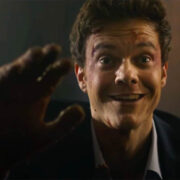PATRIOTS DAY: Love Conquers Hate
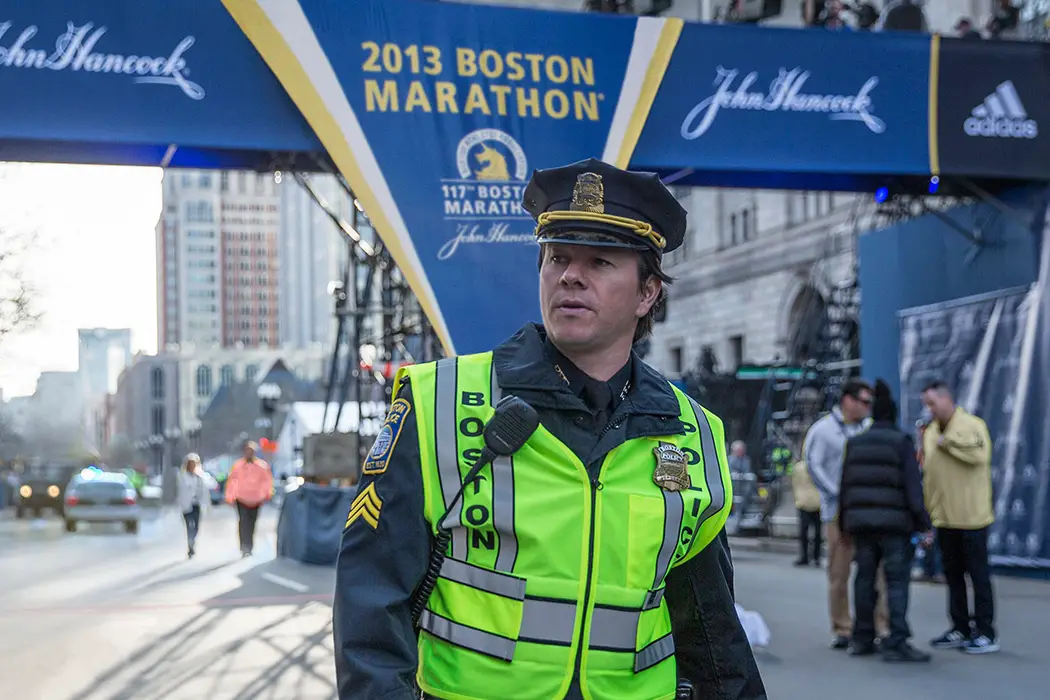
Stephanie Archer is 39 year old film fanatic living in…
There are times in every country’s history when its citizens will be faced with a horrifying disaster. Yet, it is the unity of those individuals that choose to fight, to survive and to love that can reshape and redefine the horrors of this new reality. It is how the tragedy is handled that can set the tone and the pace for the days that are to follow.
As a nation still recovering from the recent loss of 26 innocent souls, April 15, 2013 was a day that would test the strength and resilience of a community and the love of a country. When the bombs erupted at the finish line of the longest running marathon in the United States, viewers were left speechless, and those on scene – runners, bystanders and police alike – ran into danger and to those who had fallen victim to the horrors of terrorism.
Deemed the worst terrorist attack in the United States since the tragedy of 9/11, the Boston Marathon Bombings became a reminder that the fight against terrorism was still on our soil and not a fight that would only be fought overseas. Like the terror attack before it, the Boston Marathon occurred on live television, the tragedy and the horror mutually shared across the country – and the world.
Patriots Day, a film by Peter Berg, was a pleasant, yet chilling surprise. Walking into the theater, I was expecting a highly glorified representation of the events and individuals that were involved in the bombings and the days that followed. I was also expecting to be inundated with a vast array of propaganda bolstering the success and strength of the country. Yet, what was represented on the screen couldn’t have been further from it. Peter Berg, while having to display the actions of the bombers, masterfully shied away from glorification – keeping their story as closely as possible to facts and testimonials.
This movie was difficult to watch at times, as the reality of it was further heightened by the use of actual footage and surveillance video, as well as the anticipation and anxiety of knowing how actual events played out. Viewers will know the bombs will be detonating at any moment as runners begin to cross the finish line, yet what they may be surprised to find is that reliving the past may not be as easy as one may think. For many, footage of the day will have been viewed live or replayed endlessly on their local news stations – not just the day of but in the days following as well. There is a realism that pierces through the film, striking at the hearts of viewers, forcing many to relive and allowing others to witness the full story.
Patriots Day
Patriots Day is a Massachusetts state holiday celebrated to commemorate the Battle of Lexington and the Battle of Concord – the first battles of a war that would win America its independence. While these battles were held on April 19th, ironically the day the final bomber was apprehended, Patriots Day is celebrated on the third Monday of April every year. Since 1897, it has been a long standing tradition that the Boston Marathon be held on this day. It is chillingly fitting that tragedy would strike on this day, and a fight would once again commence on the soil of Boston and the state of Massachusetts – the fight against terrorism.
The beginning of Patriots Day sets the pace and tone for the entire movie, brilliantly beginning not on the day of the marathon, but the night before. Viewers are given a glimpse into each of the characters’ lives – we enter with the knowledge of what is to come, but begin at a point when we get a snapshot of what life was like for these individuals on a daily basis before tragedy struck. They are depicted as typical people in a typical life – not as the people and stories we came to know following the bombings and eventual manhunt later on.
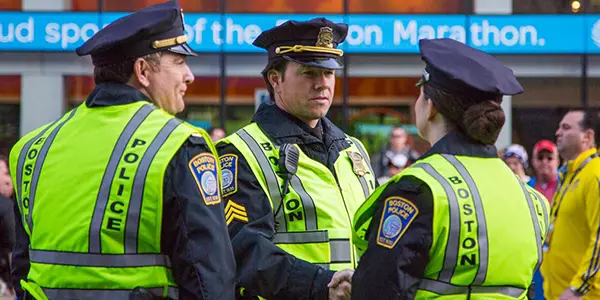
As the marathon begins and the events to come begin receiving irrepressible momentum, it is not just the film that builds anxiety and suspense – it is the awareness of knowing what is about to happen. As the clock ticks on, viewers know that the first bomb will be going off. Actual footage from the race is interlaced with the film stock, magnifying our awareness and heightening the impact when the bombs finally do explode.
The chaos that inevitably follows is pure and true, not just due to the use of footage actually captured on that day but also the incredible and painstaking performances of the cast, led by Mark Wahlberg, as they try to recreate the moments following the bomb’s explosion. While trying to tactfully recreate the horror that befell the race, the director and screenwriter Peter Berg does not shy away from bringing viewers right into the epicenter of victims – blood, limbs, and ash are clearly depicted for all to see.
Lovers scream for one another, while a father, unable to move, attempts to reassure his child until help arrives. Police run to victims, ripping their belts off their waist, falling down to the sides of the injured, utilizing everything they can to stop the bleeding, to stop the pain, and to save as many as they can. You see and feel the confusion all around and every ounce of strength it took to push through it all to secure and aid those around them.
As the last of the ambulances blare through the the streets, the FBI, led by Special Agent Richard DesLauriers (played by Kevin Bacon) arrives on scene. The tension continues, as the decision regarding who would run the investigation requires an immediate resolution and to make this decision would require a declaration of terrorism – a decision that could result in unknown consequences nationwide. As terrorism becomes an undeniable truth, a command center becomes the new focal point of the film, focusing on the desperate and timely fashion that the combined efforts of FBI and local police underwent to discover the identification of the two bombers.
From this moment on, it becomes an unrelenting manhunt to locate and apprehend the bombers before they are able to escape and possibly strike another target. As they enter Watertown, MA, a town just outside of Boston, the film engages viewers, filling in any missing holes regarding those final hours leading up to the death of one bomber and capture of another. Mark Wahlberg, Kevin Bacon, J.K. Simmons and John Goodman bring the strength of their combined talents to each of the characters they represent, beautifully rounding out this film and bringing a movie to life that should be viewed by all.
A Face To Represent The Masses
This tactful and brilliant depiction of the Boston Marathon was only strengthened by the individuals that were chosen to bring the stories of that day to life. Through many of the actors’ performances, viewers will see the heart, the hurt, and the dedication this cast went through to make sure the story was told well and was told right. Mark Wahlberg, a native of Boston, originally turned down the part, yet knowing the story would continue on with or without him, he accepted the role – he would be there to make sure it was done correctly. After viewing his performance, I have to say that he was right.
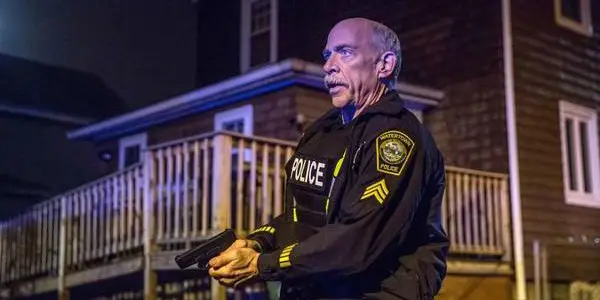
Wahlberg delivers quite possibly one of the best performances of his career thus far, playing Tommy Saunders, a fictional character immersed in a representation of real life events and people. He is the personification and embodiment of the first responders and officers that aided so many and fought to stop terrorism in its tracks. He is the culmination of a vast collection of the stories that came to light in the days following the Boston Marathon Bombing.
He is also the voice of reassurance to the people on screen and the viewers in the audience. In a time when terrorism is a fear and concern around the world, he is there to remind everyone that you may never be able to stop terrorism, but you can always fight. There will always be evil; it’s what you do in the face of that evil that matters.
The Unknown Soldier
While this is a story born from the hatred of two individuals, the main focus of this film was on the response, the determination, and the overwhelming examples of love in the aftermath. Out of all the stories from that day and the stories depicted on screen, there was one that pulled at heartstrings more than some of the others. After the dust had settled and victims has been transported to local hospitals, the bodies of three individuals, lost forever to the world, were left to lay in the street and await criminal analysis. They were no longer people, but possible key evidence that could aid officials in the investigation. One of the victims was a small eight year old boy.
As his body lay on the sidewalk, covered by a pure white table cloth, an officer was enlisted to protect the young boy. The boy in the film, whose likeness and name were left undisclosed per the request of the family, became a representation of all those unnamed individuals that are lost to acts of hate and terror – his loss a reminder to viewers that we must always be vigilant. It was in this act of unrelenting protection the officer provided and the lack of identity of the young boy who gave the ultimate sacrifice that continues to resonate long after the film has ended, echoing a similarity to a memorial in the nation’s capital – the Tomb of the Unknown Soldier.
In Arlington Cemetery, located in Washington D.C., there is a tomb containing the remains of an unknown soldier from World War II. This soldier has become the memorialized representation of those soldiers that have given the ultimate sacrifice of not only their lives, but their identity. Within this film, the boy has become the ultimate sacrifice, and his lack of identity both during the film, and for a time after the true life events, remains unknown – like many of those around the world lost to terror. Like the Tomb of the Unknown Soldier, the young boy is guarded, the officer fulfilling his duty to his citizens and to the sanctity of him. No further harm or discretion would come to the body of this young boy, the officer unrelenting in his duty until the boy was finally taken away in a local ambulance, his departure unanimously saluted by all on scene as he passed.
Boston Strong
Patriots Day did not end with the apprehension of the final Boston Marathon bomber – Dzhokhar Tsarnaev (played by Alex Wolff) was not the final image of the film. The final moments instead included segments of monologues from some of the survivors and members of the Boston and Watertown police that had been a part of these tragic events, and had just been represented on screen. Characters from the film were now true, becoming actual people and not just characters on the screen.
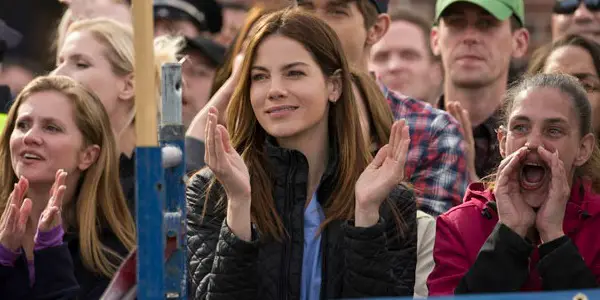
You see the recognition and praise the FBI and police received as they walk out onto Fenway Park following the apprehension of the final bomber. You hear from the young couple who had each lost their limbs – including footage of their first participation in the 2016 Boston Marathon with their prosthetic running legs carrying them across the finish line. They cross the finish line and run into the arms of each other and into the arms of those who had overcome the same adversaries that this tragic day had forced them all to face.
In the final moments of Patriots Day, there was no hate shown, only love, support, and gratitude – from fellow survivors, from family, and from a community. It is this response and continuing fight forward that will always make them Boston Strong.
Conclusion
Patriots Day was a chilling retelling of the tragic events of the Boston Marathon. It was executed delicately – tactfully and brilliantly bringing viewers back to that tragic day and the days that would follow. With a strong director at the helm and a strong cast to support it, this film was a successful representation not only of tragedy but of the love, determination, and support that can spur out of the ashes.
While difficult to watch at times, the film will be a lasting testament to the the strength of a community and the strength of a nation.
Have you seen Patriots Day? Tell us what you thought in the comments below!
Patriots Day is currently screening in U.s. theaters, and will be released in the UK on February 23, 2017. For all international release dates, see here.
Does content like this matter to you?
Become a Member and support film journalism. Unlock access to all of Film Inquiry`s great articles. Join a community of like-minded readers who are passionate about cinema - get access to our private members Network, give back to independent filmmakers, and more.









